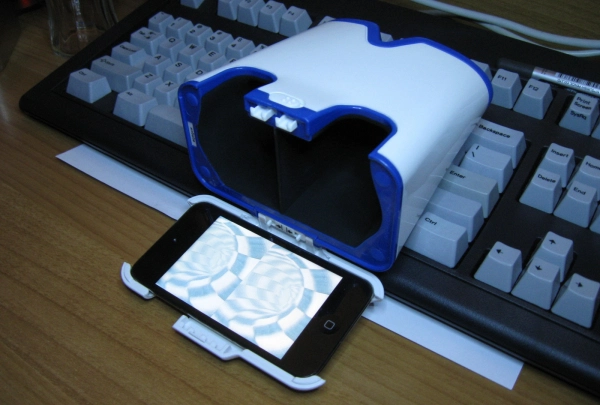
John Tsiombikas nuclear@mutantstargoat.com
11 September 2011
[Edit: this app is now available on the appstore, and has a dedicated web page]
The fun never stops with stereoscopic rendering. I posted previously about my earlier attempts with anaglyphs and shutter glasses, and all that was really fun, but not without drawbacks. Shutter glasses are awesome, but the only computer I have with a stereo output is an old SGI workstation, which isn't up to the task to render modern 3D graphics, and doesn't event give me stereo OpenGL visuals and a depth buffer at the same time. Anaglyph glasses are cheap and work everywhere, but they mess up the colors and they have a serious problem with ghosting, ruining the stereoscopic effect.
So, it was with great enthousiasm that I learned there's a cheap and simple stereoscopic viewing contraption for the iphone produced by hasbro. It's sortof like a viewmaster, only instead of cardboard reel with stereoscopic pictures, it has a place to attach an iphone or ipod touch on the back of it, using it as the source of the stereoscopic image presented to the user. What needs to be done iphone-side is simple enough. Just make it display a stereo pair side by side in a split-screen. The only drawback of this approach, is that since the iphone display is split in half, the achievable aspect ratio is slightly less than 1 which has an impact on immersion, making the perception more like looking through a squarish window into the 3D world rather than being surrounded by it. Still very impressive for a 28 dollar plastic widget.
Buying this apparatus gave me the final push I needed to get onto iOS programming. I find Objective-C unspeakably ugly and the Apple APIs needlessly convoluted, which was why I kept pushing this back, but I really wanted to see my code in glorious stereoscopic ... glory, so I bit the bullet and ported over the stereoscopic tunnel program I've written originally for the SGI when I bought the shutter glasses.
The result is awesome; full stereo 3d without color degradation on modern programmable graphics hardware. Unfortunately one has to use the crippled version of OpenGL that's become so popular on mobile devices lately: OpenGL ES 2.0 (see webgl post for my rant on that issue), but it was easy enough to make a wrapper that brings back immediate mode and the matrix stack.
In case you'd like to play around with the code, here's a tarball. Feel free to use it under the terms of the GPLv3. It includes an Xcode project that compiles it for the iphone and a makefile for normal systems. If you run the program on your iphone tap anywhere on the screen to go to the options GUI to enable stereo rendering or change between the simple and the normal-mapped tunnel (keys s and b on the PC version).
This was initially posted in my old wordpress blog. Visit the original version to see any comments.